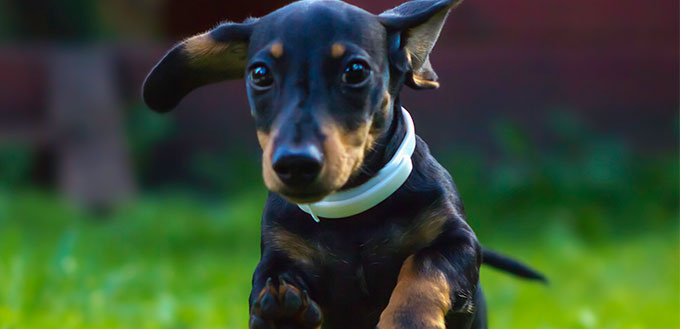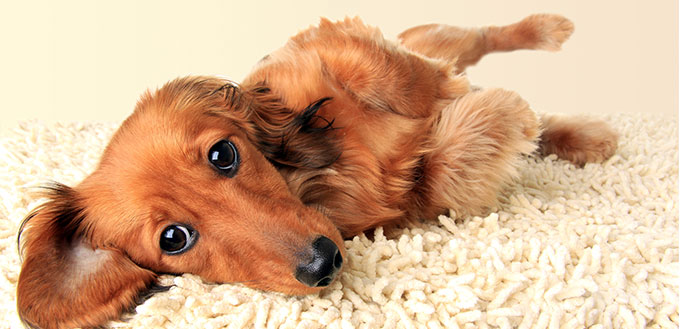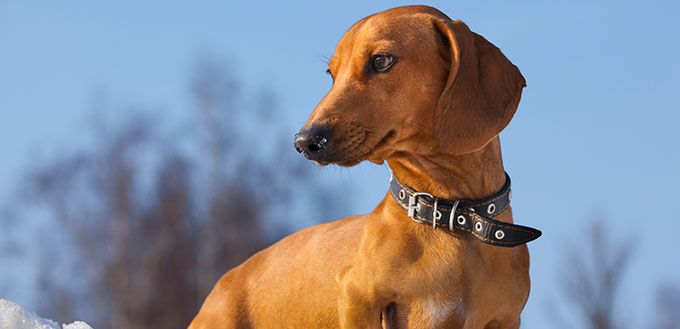The unmistakable silhouette of the Dachshund is instantly recognizable. The long body and short legs have enchanted generations of the breed’s enthusiasts. But don’t be deceived by appearances; this little dog has got a big personality! Their bravery is matched only by their stubbornness. Yet, in the end, their irresistible charm will win you over.
Although they originated in Germany, they have been amongst the most popular breeds for family pets in the US for over half a century. There are three coat types within the breed which are: smooth, wirehaired and longhaired. If you are an owner who knows how to show that you are the boss, this could be the ideal breed for you. Here’s what you need to know about this clever, funny and iconic little dog breed.
History of the Dachshund
The breed originated in Germany and the name “Dachshund” is the German word for “badger dog”. The Dachshund is the national symbol of Germany. It is a well-established breed that dates back to the 1600s when it was used to dig into badger dens, hence the need to have a long and low body. Badgers are a formidable opponent for such a little dog so the characteristics of intelligence, bravery and perseverance were also highly prized! Of course, the flip side of perseverance is stubbornness and that is the trait most often noted in the breed today. They also needed to have a very loud bark so that those above ground could identify where they were in the underground badger tunnel and this is why Dachshunds have a surprisingly loud bark for such a little pooch.
The smooth-haired variety was first created by crossing the Braque breed with Pinschers but some experts claim that French Basset Hounds were crossed with the breed also. Later, the wirehaired and longhaired varieties were bred by crossing the Dachshunds with Spaniels and Terriers. Dogs with wiry coats were used for working in thorny brier patches and dogs with long coats were bred for working in colder climates.
From around 1800, they were used more as companion dogs and Queen Victoria was a big fan of the breed. A variant of the breed, the miniature Dachshund, also emerged at this time. In 1885 they were formally recognized by the American Kennel Club and were a big hit with US pet lovers. Their popularity was severely dented by the German participation in both World Wars. Nevertheless, their popularity was quick to recover and they are now ranked as the 13th most popular breed in the US today.

Quick Facts
The Dachshund is a very well known breed that is instantly recognizable but here are some quick facts about this unique breed that may not already know.
- They live for around 12 to 16 years and are generally a healthy breed provided you choose the best dog food for Dachshunds and give them plenty of exercise.
- They have a low, long body and sort legs. There is very little difference in the build of males compared to females. You can expect both to reach around eight to nine inches in height when they reach adulthood and to weigh in at between 11 and 32 pounds.
- They owe their unique body shape to years of breeding. They have a long muscular body that is solid and an elongated, convex head.
- The Miniature Dachshund is also recognized as a breed by the AKC and they grow to only five inches or so in height and reach 11 pounds. An even smaller, toy variety is recognized in Europe but not in the US.
Things You Should Know
The intelligent and brave Dachshund makes an excellent companion dog and family pet. However, they do need a firm hand right from the start to show them who is the boss. If you are considering welcoming a gorgeous Dachshund into your home, here are a few things that you need to bear in mind.
Training
Dachshunds are not the hardest breed to train but they are not the easiest either! There is no doubting their intelligence but their independence and their stubborn natures can get in the way. Your first challenge is to gain their attention, especially if you are outdoors. Because they have a strong prey drive, as soon as they pick up a scent they will be off and will pay little attention to you!
Related Post: Best Dog Training Books
Positive, reward-based training is the only approach that can work. Dachshunds are sensitive little souls who will never respond to harsh training methods. You need to be firm, fair and consistent. Use treats and games as rewards and limit training sessions to no more than 10 minutes or they will lose interest. Repetition doesn’t work with Dachshunds because they soon get bored! Housebreaking can also be a problem and it can take some time, as well as a lot of patience. Many owners find that they need to use the crate-training approach.
Above all, you must resist the temptation to treat your Dachshund pup like your baby. You must show leadership and make it clear that you are in charge. You need clear rules that are consistently enforced. If you don’t, they will take over and will start to tell you what to do which is a recipe for disaster.
Feeding
You need to be careful with your Dachshund’s diet because they have a tendency to become overweight. This is not good for their overall health but also puts a big strain on their back which is vulnerable to injury because it is so long. The best food for Dachshunds will have plenty of lean meat as the main ingredient and will not contain any fillers that make them pile on the calories but have no nutritional value.
Also, avoid feeding them scraps at the table as this can lead them into bad habits and can make them pile on the pounds. Foods based on natural foods that have easy to digest ingredients and which do not contain grains are the best choice.
Related Post: Best Grain Free Dog Food
Exercise
The Dachshund may have little legs but they are no couch potato. They are inquisitive, energetic dogs who ideally like to have a pack walk. Running around an apartment is not going to be enough for them.
They need two walks every day of a moderate length. You won’t cover much ground because they have such short legs but they do have remarkable stamina. The regular walks will help to keep them psychologically stimulated and will stop them from becoming overweight. They also need exercise to keep their back muscles strong. Their back is prone to injury and inactivity makes this worse.
They love to be with humans and will relish play sessions with you in the park or in the garden. However, you do need to take care when you are out and about because they can get trodden on. Also, don’t let them jump off furniture or run up and downstairs because this can trigger a back injury.

Socialization
Dachshunds need adequate socialization from a very early age so they learn to be calm and friendly towards other dogs and humans. There can be issues between Dachshunds and children, especially young children. However, if they get used to them at a young age, you can avoid a lot of problems and they can be molded into a lovely family pet.
They will get on with other dogs but they will expect to be in charge which can lead to conflict so socialization is critical. Try out some puppy classes with your young pup so they can learn how to get on with other dogs and share toys etc.
Grooming
There will be some shedding but it will not be excessive. The wirehaired and long-haired varieties will need more frequent grooming with a suitable brush. Bathing does not have to be frequent but their droopy ears need to be inspected regularly because they can get infected. The ears also need to be cleaned every week with a cotton ball dipped in ear cleaner. Don’t insert it too deep into the ear.
Related Post: Best Dog Shedding Brush
Their nails need a monthly trim, you will know that they need doing because you will hear them tapping on the floor. Dental health is very important in this breed so brush their teeth every day if possible.
Related Post: Best Dog Toothpaste and Dog Toothbrushes
Health
This is a generally healthy breed with relatively few inherited health disorders that you need to be on the lookout for. The national breed club have not recommended any routine health tests which is good news.
However, that does not mean that they never have health problems. Here are a few things to look out for.
- Spinal problems
The most serious health issue facing your Dachshund is a problem with their spine. Their elongated body is what attracts us to them but it does put them at higher risk of spinal injury and disc disease. You need to take great care of your dog jumping off high furniture and steps. It is thought that as many as one in every four Dachshunds will suffer from some sort of back problem in their lifetime.
Intervertebral disc disease is the most common manifestation of this issue. It can cause a lot of pain and can sadly eventually cause paralysis in many dogs. There are several risk factors including high-impact running and jumping, weight gain and irresponsible breeding practices that do not control for this characteristic.
You will probably first notice this when your dog starts walking strangely. They may seem wobbly or may not be able to walk at all. You may also notice small, fast movements of their back muscles which are spasms. There could also be a change in their posture. Your pooch may show that they are in pain by refusing to eat, by avoiding physical activities and by withdrawing from the family.
Your vet needs to be consulted right away. They will investigate the problem and will carry out appropriate tests. The treatment may include pain-relief, muscle relaxants, cage confinement or surgery. It is not uncommon for the spinal problem to leave a Dachshund’s rear legs completely paralyzed. If this happens, it does not have to be the end of family walks because you can get a dog wheelchair. Your vet can make recommendations on how to use them successfully.
- Obesity
The problem of excessive weight is related to spinal problems. Dogs that are overweight are more likely to get spinal problems and dogs that have limited mobility due to a spinal problem are more likely to become overweight.
You need to be on the lookout for this and take control by only offering a healthy diet that controls the calories that your dog ingests. Avoid treats packed with calories and do not feed them table scraps.
Related Post: Best Dog Food for Weight Loss

Temperament
Dachshund temperaments vary by variety. The wirehaired Dachshunds have some Terrier temperament and can be mischievous but the longhaired Dachshunds tend to be calm and quieter. All varieties are intelligent, brave and energetic. They were bred to persevere at their tasks so they can be stubborn and you will find that they want to do things their way. This can make training them a challenge.
They can take a dislike to children so watch out for this when you are in your local park. It can be helped with socialization and training but they still may have a problem with young children that they don’t know. You don’t need to have the same concerns about other pets though because this is rarely a problem.
Be prepared for quite a lot of (loud) barking and some bossy behavior. You must show them that you are the boss or they will assume that they are! They require a patient, mature and confident human pack leader to keep them in line! If this is you, then the Dachshund could be your ideal family pet and the cutest member of your family.
Related Post: Best App to Stop Dog Barking
More Pet Product Reviews
Flea Killer For Your Yard
Raised Dog Beds
Automatic Dog Feeders
Dog Baskets For Bikes
Kayaks for Dogs
Dog Strollers
Dog Backpack Carriers
Dog Water Bottles
Dog Crate Covers





